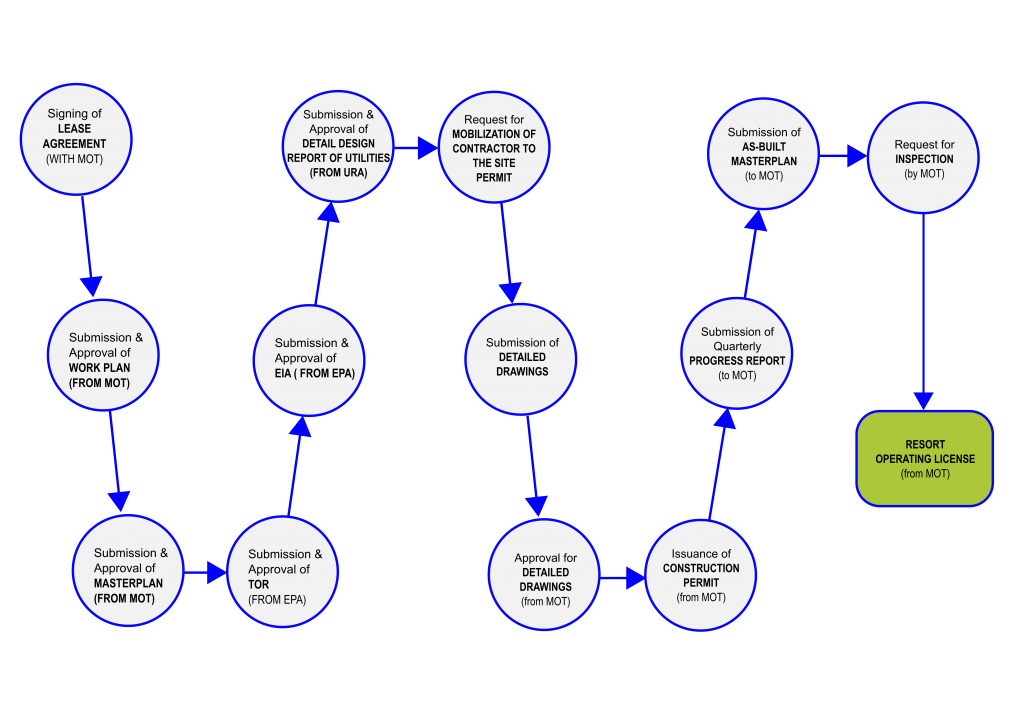Tourism is one of the most important industry in the Maldives. Island have been dedicated for operating and tourism which provides exclusive and higher level services to the tourists. The process of obtaining license for operating a resort in the Maldives is quite transparent. The developer has to sign a LEASE AGREEMENT with the Ministry of Tourism (MOT) of the Maldives.

Based on the lease agreement, the developer/operator has to submit a WORK PLAN to the MOT. The flowchart above represents a typical process of approval.
After evaluating the plan, MOT gives approval for the plan. The developer then proceed to conceptualization of the resort and produce a master plan for the development. The MASTER PLAN requires approval from the MOT. When the master plan is approved, the developer may proceed to conceptualizing of the architectural, engineering of individual developments, such as guest lodgings, restaurants, coffeeshops, back of house buildings (power house, desalination plant house, accommodation for staff etc.).
While architectural and engineering design being conceptualized, in parallel a process to align the development with environmental regulations in the Maldives, the developer has to carry out an Environmental Impact Assessment (EIA) for the development. How intensive such an assessment may depend on number of factors, type of development, the location of the island, the habitat, the setting of the island. Hence, to conclude on the the methodology of EIA, the Environmental Protection Agency (EPA) would decide the terms of reference (TOR) for the EIA. When the TOR for the EIA is issued by EPA, the developer may proceed carrying out the required EIA for the project. Licensed professional from the Maldives is required to carryout the EIA.
Usually the resorts islands of the Maldives are isolated from the main islands, hence, the utilities have to be managed by the resort operator. All the electrical power required for the operation, from its production to the distribution within the island has be done by the developer. Similar are other utilities, such as fresh water production and distribution. Sewerage system and waste management. To ensure such utilities are in compliant to the current laws and regulations the developer has to submit DETAILED DESIGN REPORT OF UTILITIES to the Utility Regulator Authority (URA) and get approval for the utility design while proceeding with architectural and engineering design.
When the developer gets approval for utility design, he may request MOT to issue per to mobilize to the island for the setting up of temporary buildings, yard, etc before start of construction. However, actual construction cannot be started unless a CONSTRUCTION PERMIT is issued from the MOT.
To obtain the construction permit, the developer has to produce detailed architectural, structural, MEP and FIRE drawings and submit to the MOT. The detailed drawings produced shall be stamped and signed by licensed architect and structural engineering in the Maldives. After evaluating the drawings, ensuring the detailed design is in compliance with the the approved master plan by MOT, if there is no issue, MOT may proceed to give Construction permit.
An import duty is levied to most of the items imported to the Maldives. However, some material brought for resort development, especially structural development may get duty exemption. To get that exemption, the developer has to submit a certified Bills of Quantities ( BOQ) of the development by a registered Quantity Surveyor in the Maldives.
MOT requires following up of the construction of resorts. Hence, submission of a quarterly, four times per year is required.
When the construction completed, the developer must submit an AS-BUILT MASTER PLAN to the MOT. This should consider minor changes that may have happened to the plan during the construction process.
When MOT receives the as-built plan, the developer may request MOT to visit for a preliminary inspection. After Preliminary inspection, if any correction guided by MOT team attended, the developer may request MOT for final inspection.
After final inspection, MOT may issue the RESORT OPERATING LICENCE.